Civil Engineering Report: Risk Assessment for Silver Bridge Failure
VerifiedAdded on 2023/06/03
|14
|3748
|463
Report
AI Summary
This report provides a comprehensive risk assessment of the Silver Bridge collapse, examining the causes of the failure, types of failure, and risk management strategies. The introduction highlights the importance of risk assessment in identifying hazards, with the Silver Bridge incident serving as a case study. The report details design and construction errors, overloading, material defects, and lack of maintenance as key factors contributing to the collapse. It outlines a risk management strategy process that includes hazard identification, evaluating risk, and implementing control measures. Various risk management strategies, such as risk avoidance, dispersion, mitigation, and acceptance, are discussed. Additionally, risk protection strategies, including safety training, crew safety meetings, and workplace cleanliness, are presented to prevent future incidents. The report emphasizes the importance of a proactive approach to safety and the role of proper risk assessment in preventing such tragedies. This report is contributed by a student to Desklib, a platform that provides AI based study tools for students.
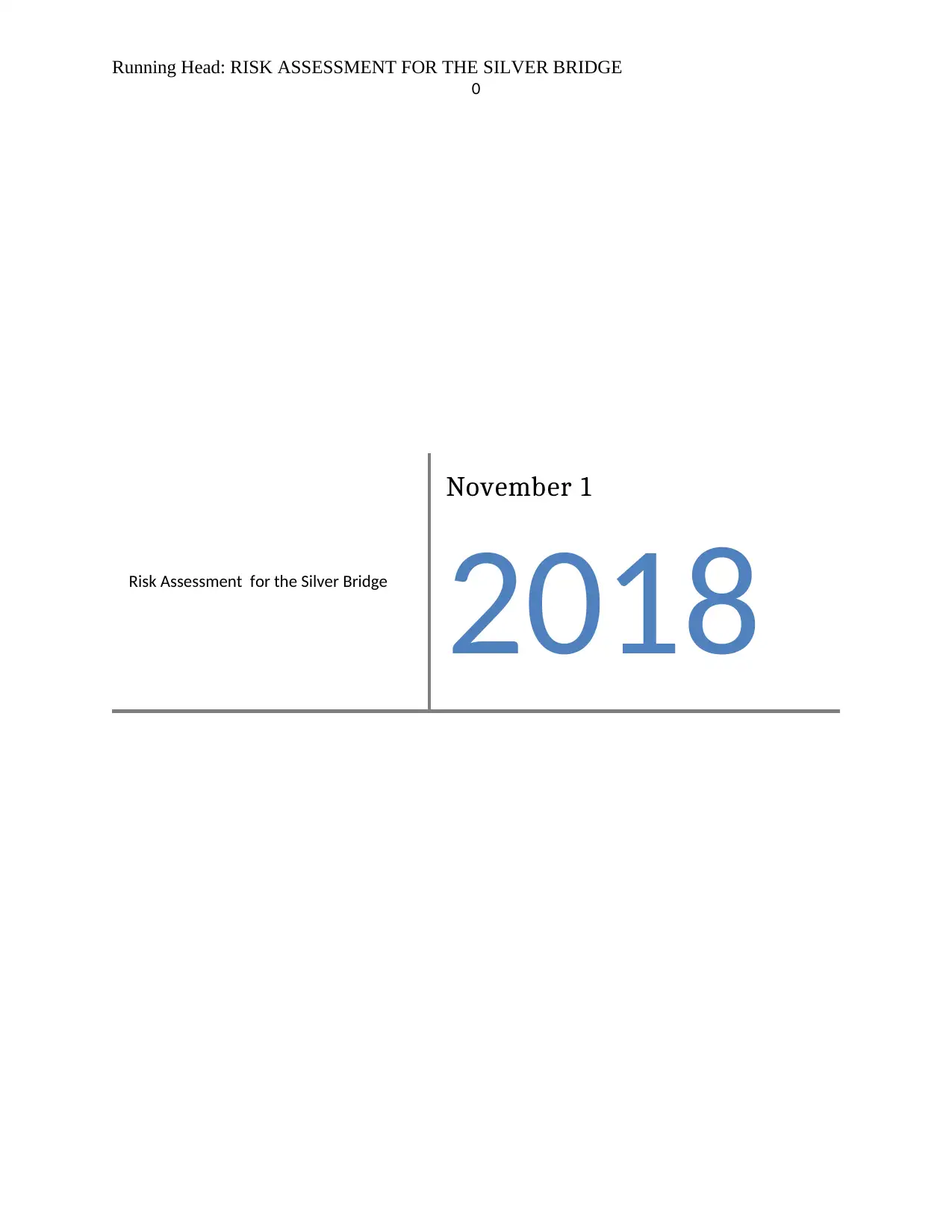
Running Head: RISK ASSESSMENT FOR THE SILVER BRIDGE
0
Risk Assessment for the Silver Bridge
November 1
2018
0
Risk Assessment for the Silver Bridge
November 1
2018
Paraphrase This Document
Need a fresh take? Get an instant paraphrase of this document with our AI Paraphraser

RISK ASSESSMENT FOR THE SILVER BRIDGE
1
Introduction
Risk assessment includes the overall process to identify risk and hazards. And hazard is
something that could be dangerous to an individual, to an individual’s health and safety and to
the company’s or an individual’s reputation. According to Occupational Safety, and Health
(OSH), “hazard is a condition that poses a level of potential risk (Burke, Scheurer & Meredith,
2007).
In the non-building sector, the bridge is the biggest growth segment also the highly
impacted in the bridge collapsed (U.S. Bridge, 2018). On the afternoon of December 15, 1967,
the Silver Bridge collapsed while handling the load of heavy traffic and killed around 46 people
and many others were injured. Around 5’o clock in the evening, the chain on the upriver side
suddenly snapped. The roadway started to incline; cars started falling into the river 80 feet
below. There was one witness who told to Time magazine, "The Bridge just capsized over,
starting slowly on the Ohio side and then folding like a deck of cards to the West Virginia side."
The bridge provided crossing for US route 35 over the Ohio River and connected to Columbus,
Charleston, and West Virginia. The bridge was built by the American bridge company of
Pittsburgh. According to the National Transportation Safety Board report, “The accident was
caused by a fractured eye bar”. The government eventually improved the way bridges were
examined to ensure safety and functionality. If the proper risk assessment was implemented then
the whole incident was avoidable (Johnston, 2007).
The safety breaches that led to the incident
1
Introduction
Risk assessment includes the overall process to identify risk and hazards. And hazard is
something that could be dangerous to an individual, to an individual’s health and safety and to
the company’s or an individual’s reputation. According to Occupational Safety, and Health
(OSH), “hazard is a condition that poses a level of potential risk (Burke, Scheurer & Meredith,
2007).
In the non-building sector, the bridge is the biggest growth segment also the highly
impacted in the bridge collapsed (U.S. Bridge, 2018). On the afternoon of December 15, 1967,
the Silver Bridge collapsed while handling the load of heavy traffic and killed around 46 people
and many others were injured. Around 5’o clock in the evening, the chain on the upriver side
suddenly snapped. The roadway started to incline; cars started falling into the river 80 feet
below. There was one witness who told to Time magazine, "The Bridge just capsized over,
starting slowly on the Ohio side and then folding like a deck of cards to the West Virginia side."
The bridge provided crossing for US route 35 over the Ohio River and connected to Columbus,
Charleston, and West Virginia. The bridge was built by the American bridge company of
Pittsburgh. According to the National Transportation Safety Board report, “The accident was
caused by a fractured eye bar”. The government eventually improved the way bridges were
examined to ensure safety and functionality. If the proper risk assessment was implemented then
the whole incident was avoidable (Johnston, 2007).
The safety breaches that led to the incident
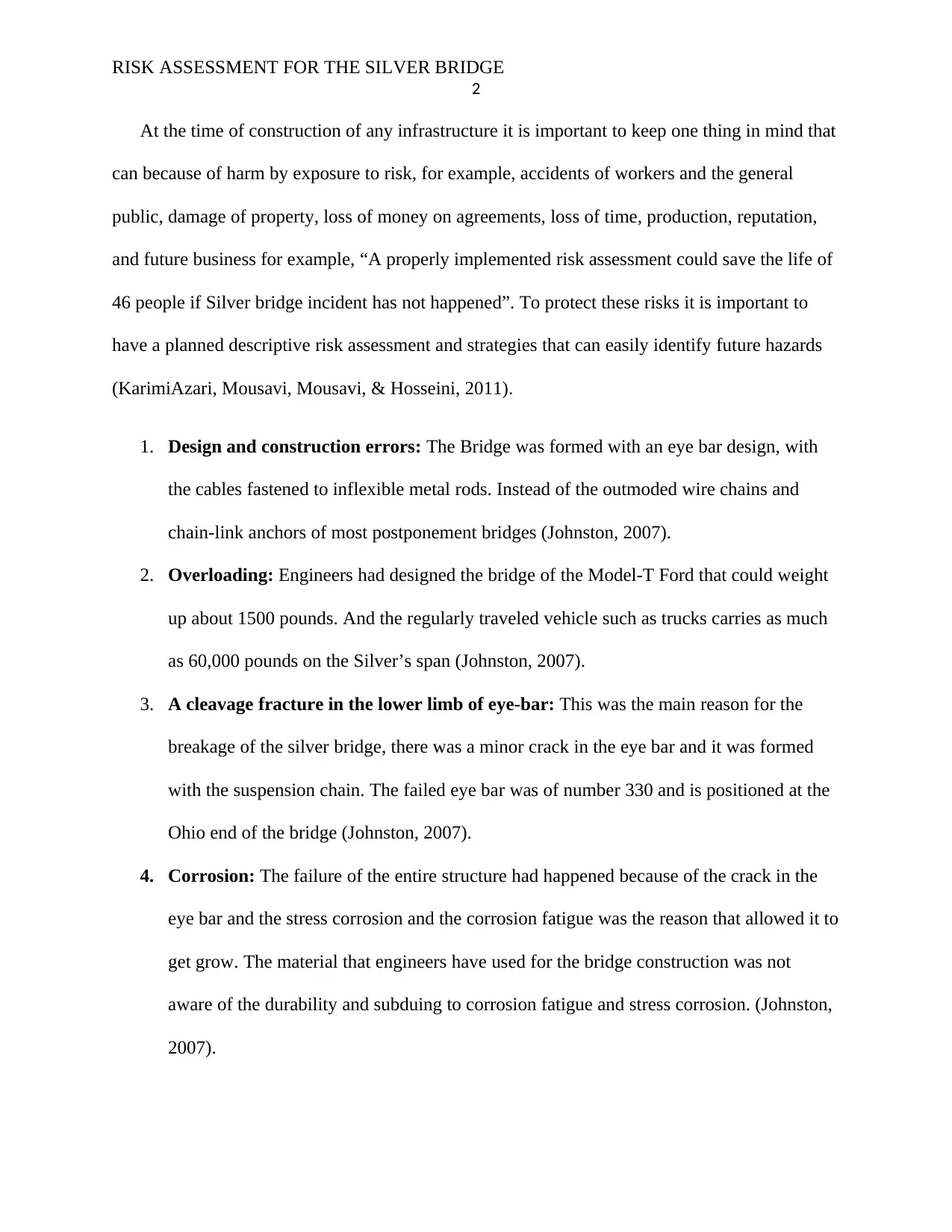
RISK ASSESSMENT FOR THE SILVER BRIDGE
2
At the time of construction of any infrastructure it is important to keep one thing in mind that
can because of harm by exposure to risk, for example, accidents of workers and the general
public, damage of property, loss of money on agreements, loss of time, production, reputation,
and future business for example, “A properly implemented risk assessment could save the life of
46 people if Silver bridge incident has not happened”. To protect these risks it is important to
have a planned descriptive risk assessment and strategies that can easily identify future hazards
(KarimiAzari, Mousavi, Mousavi, & Hosseini, 2011).
1. Design and construction errors: The Bridge was formed with an eye bar design, with
the cables fastened to inflexible metal rods. Instead of the outmoded wire chains and
chain-link anchors of most postponement bridges (Johnston, 2007).
2. Overloading: Engineers had designed the bridge of the Model-T Ford that could weight
up about 1500 pounds. And the regularly traveled vehicle such as trucks carries as much
as 60,000 pounds on the Silver’s span (Johnston, 2007).
3. A cleavage fracture in the lower limb of eye-bar: This was the main reason for the
breakage of the silver bridge, there was a minor crack in the eye bar and it was formed
with the suspension chain. The failed eye bar was of number 330 and is positioned at the
Ohio end of the bridge (Johnston, 2007).
4. Corrosion: The failure of the entire structure had happened because of the crack in the
eye bar and the stress corrosion and the corrosion fatigue was the reason that allowed it to
get grow. The material that engineers have used for the bridge construction was not
aware of the durability and subduing to corrosion fatigue and stress corrosion. (Johnston,
2007).
2
At the time of construction of any infrastructure it is important to keep one thing in mind that
can because of harm by exposure to risk, for example, accidents of workers and the general
public, damage of property, loss of money on agreements, loss of time, production, reputation,
and future business for example, “A properly implemented risk assessment could save the life of
46 people if Silver bridge incident has not happened”. To protect these risks it is important to
have a planned descriptive risk assessment and strategies that can easily identify future hazards
(KarimiAzari, Mousavi, Mousavi, & Hosseini, 2011).
1. Design and construction errors: The Bridge was formed with an eye bar design, with
the cables fastened to inflexible metal rods. Instead of the outmoded wire chains and
chain-link anchors of most postponement bridges (Johnston, 2007).
2. Overloading: Engineers had designed the bridge of the Model-T Ford that could weight
up about 1500 pounds. And the regularly traveled vehicle such as trucks carries as much
as 60,000 pounds on the Silver’s span (Johnston, 2007).
3. A cleavage fracture in the lower limb of eye-bar: This was the main reason for the
breakage of the silver bridge, there was a minor crack in the eye bar and it was formed
with the suspension chain. The failed eye bar was of number 330 and is positioned at the
Ohio end of the bridge (Johnston, 2007).
4. Corrosion: The failure of the entire structure had happened because of the crack in the
eye bar and the stress corrosion and the corrosion fatigue was the reason that allowed it to
get grow. The material that engineers have used for the bridge construction was not
aware of the durability and subduing to corrosion fatigue and stress corrosion. (Johnston,
2007).
⊘ This is a preview!⊘
Do you want full access?
Subscribe today to unlock all pages.

Trusted by 1+ million students worldwide
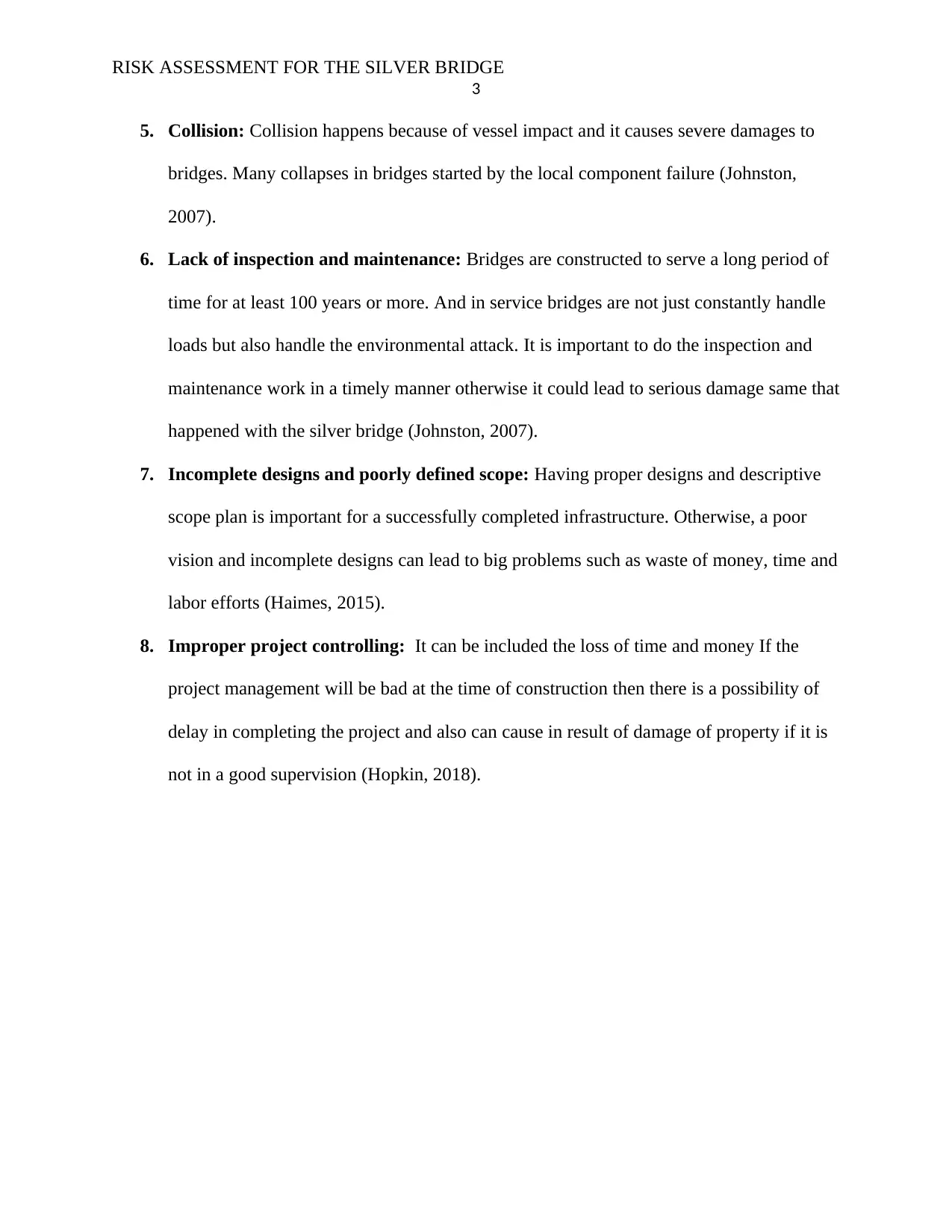
RISK ASSESSMENT FOR THE SILVER BRIDGE
3
5. Collision: Collision happens because of vessel impact and it causes severe damages to
bridges. Many collapses in bridges started by the local component failure (Johnston,
2007).
6. Lack of inspection and maintenance: Bridges are constructed to serve a long period of
time for at least 100 years or more. And in service bridges are not just constantly handle
loads but also handle the environmental attack. It is important to do the inspection and
maintenance work in a timely manner otherwise it could lead to serious damage same that
happened with the silver bridge (Johnston, 2007).
7. Incomplete designs and poorly defined scope: Having proper designs and descriptive
scope plan is important for a successfully completed infrastructure. Otherwise, a poor
vision and incomplete designs can lead to big problems such as waste of money, time and
labor efforts (Haimes, 2015).
8. Improper project controlling: It can be included the loss of time and money If the
project management will be bad at the time of construction then there is a possibility of
delay in completing the project and also can cause in result of damage of property if it is
not in a good supervision (Hopkin, 2018).
3
5. Collision: Collision happens because of vessel impact and it causes severe damages to
bridges. Many collapses in bridges started by the local component failure (Johnston,
2007).
6. Lack of inspection and maintenance: Bridges are constructed to serve a long period of
time for at least 100 years or more. And in service bridges are not just constantly handle
loads but also handle the environmental attack. It is important to do the inspection and
maintenance work in a timely manner otherwise it could lead to serious damage same that
happened with the silver bridge (Johnston, 2007).
7. Incomplete designs and poorly defined scope: Having proper designs and descriptive
scope plan is important for a successfully completed infrastructure. Otherwise, a poor
vision and incomplete designs can lead to big problems such as waste of money, time and
labor efforts (Haimes, 2015).
8. Improper project controlling: It can be included the loss of time and money If the
project management will be bad at the time of construction then there is a possibility of
delay in completing the project and also can cause in result of damage of property if it is
not in a good supervision (Hopkin, 2018).
Paraphrase This Document
Need a fresh take? Get an instant paraphrase of this document with our AI Paraphraser

RISK ASSESSMENT FOR THE SILVER BRIDGE
4
Failure Types of failed bridge for each of the causes of bridge failures
Cause of failure
Design Error
Lack of maintenance
Deficiency in construction
Material defect
Earthquake
Scour
Flood
Collision
Environmental
Degradation
Overload
Fire
Wind
Source: - Bridge Master (2017)
Risk management strategy process
Risk management
Risk management is the process of identifying the hazards in advance; analyze the risk
and taking protective steps to reduce it (The Economic Times, 2018).
1. Identify the hazard: For identifying the hazard, it is always very important to know the
difference between risk and danger. The risk is the first step where the hazard can be
realized and the hazard is a possibility to cause harm. In other words, it is a process to
assume the future and controlling the possibilities. Identification of risk includes the
types of risks such as schedule risk, reputational risk, health, and safety risk and cost risk
for example; crack in the eye bar of the silver bridge was an identified hazard (Hopkin,
2018).
4
Failure Types of failed bridge for each of the causes of bridge failures
Cause of failure
Design Error
Lack of maintenance
Deficiency in construction
Material defect
Earthquake
Scour
Flood
Collision
Environmental
Degradation
Overload
Fire
Wind
Source: - Bridge Master (2017)
Risk management strategy process
Risk management
Risk management is the process of identifying the hazards in advance; analyze the risk
and taking protective steps to reduce it (The Economic Times, 2018).
1. Identify the hazard: For identifying the hazard, it is always very important to know the
difference between risk and danger. The risk is the first step where the hazard can be
realized and the hazard is a possibility to cause harm. In other words, it is a process to
assume the future and controlling the possibilities. Identification of risk includes the
types of risks such as schedule risk, reputational risk, health, and safety risk and cost risk
for example; crack in the eye bar of the silver bridge was an identified hazard (Hopkin,
2018).
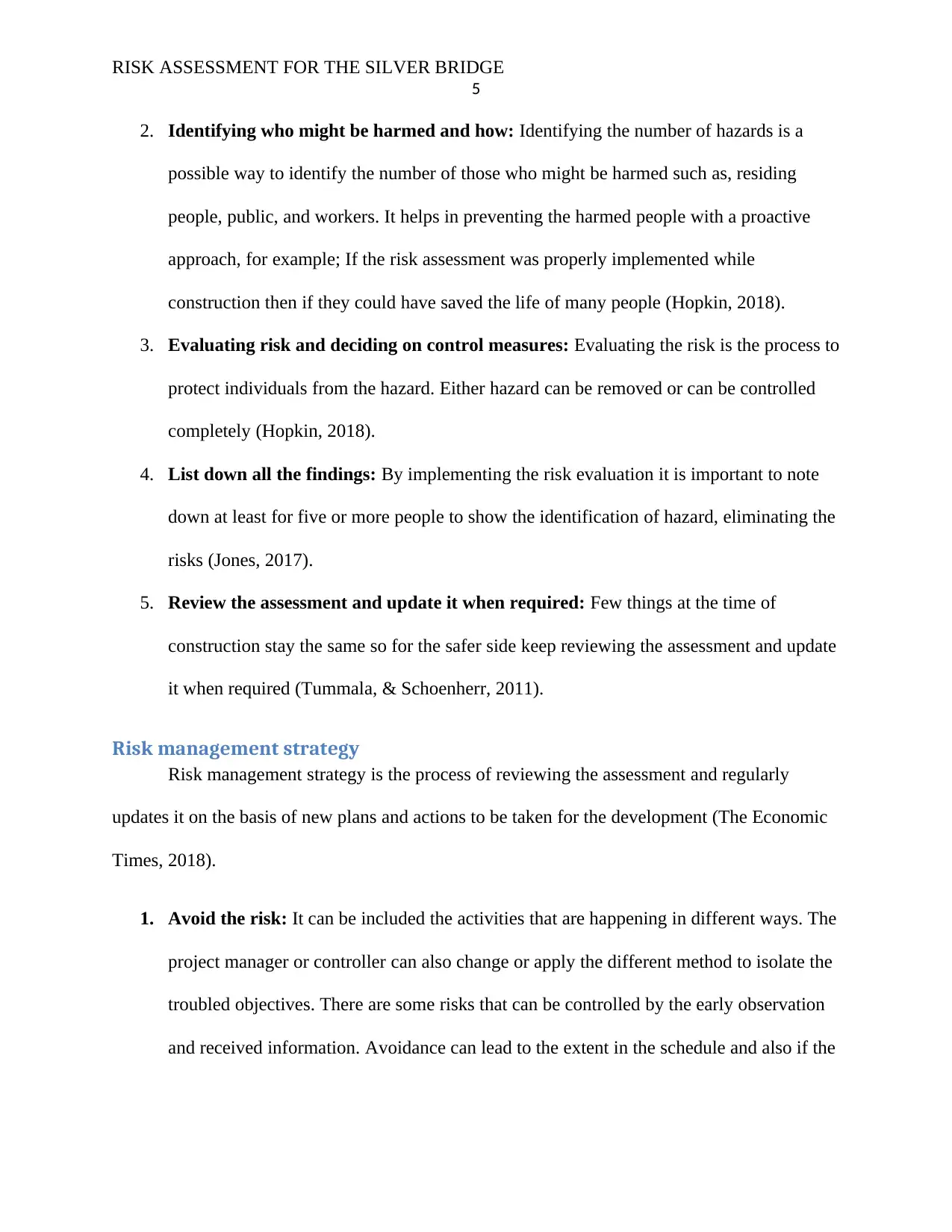
RISK ASSESSMENT FOR THE SILVER BRIDGE
5
2. Identifying who might be harmed and how: Identifying the number of hazards is a
possible way to identify the number of those who might be harmed such as, residing
people, public, and workers. It helps in preventing the harmed people with a proactive
approach, for example; If the risk assessment was properly implemented while
construction then if they could have saved the life of many people (Hopkin, 2018).
3. Evaluating risk and deciding on control measures: Evaluating the risk is the process to
protect individuals from the hazard. Either hazard can be removed or can be controlled
completely (Hopkin, 2018).
4. List down all the findings: By implementing the risk evaluation it is important to note
down at least for five or more people to show the identification of hazard, eliminating the
risks (Jones, 2017).
5. Review the assessment and update it when required: Few things at the time of
construction stay the same so for the safer side keep reviewing the assessment and update
it when required (Tummala, & Schoenherr, 2011).
Risk management strategy
Risk management strategy is the process of reviewing the assessment and regularly
updates it on the basis of new plans and actions to be taken for the development (The Economic
Times, 2018).
1. Avoid the risk: It can be included the activities that are happening in different ways. The
project manager or controller can also change or apply the different method to isolate the
troubled objectives. There are some risks that can be controlled by the early observation
and received information. Avoidance can lead to the extent in the schedule and also if the
5
2. Identifying who might be harmed and how: Identifying the number of hazards is a
possible way to identify the number of those who might be harmed such as, residing
people, public, and workers. It helps in preventing the harmed people with a proactive
approach, for example; If the risk assessment was properly implemented while
construction then if they could have saved the life of many people (Hopkin, 2018).
3. Evaluating risk and deciding on control measures: Evaluating the risk is the process to
protect individuals from the hazard. Either hazard can be removed or can be controlled
completely (Hopkin, 2018).
4. List down all the findings: By implementing the risk evaluation it is important to note
down at least for five or more people to show the identification of hazard, eliminating the
risks (Jones, 2017).
5. Review the assessment and update it when required: Few things at the time of
construction stay the same so for the safer side keep reviewing the assessment and update
it when required (Tummala, & Schoenherr, 2011).
Risk management strategy
Risk management strategy is the process of reviewing the assessment and regularly
updates it on the basis of new plans and actions to be taken for the development (The Economic
Times, 2018).
1. Avoid the risk: It can be included the activities that are happening in different ways. The
project manager or controller can also change or apply the different method to isolate the
troubled objectives. There are some risks that can be controlled by the early observation
and received information. Avoidance can lead to the extent in the schedule and also if the
⊘ This is a preview!⊘
Do you want full access?
Subscribe today to unlock all pages.

Trusted by 1+ million students worldwide
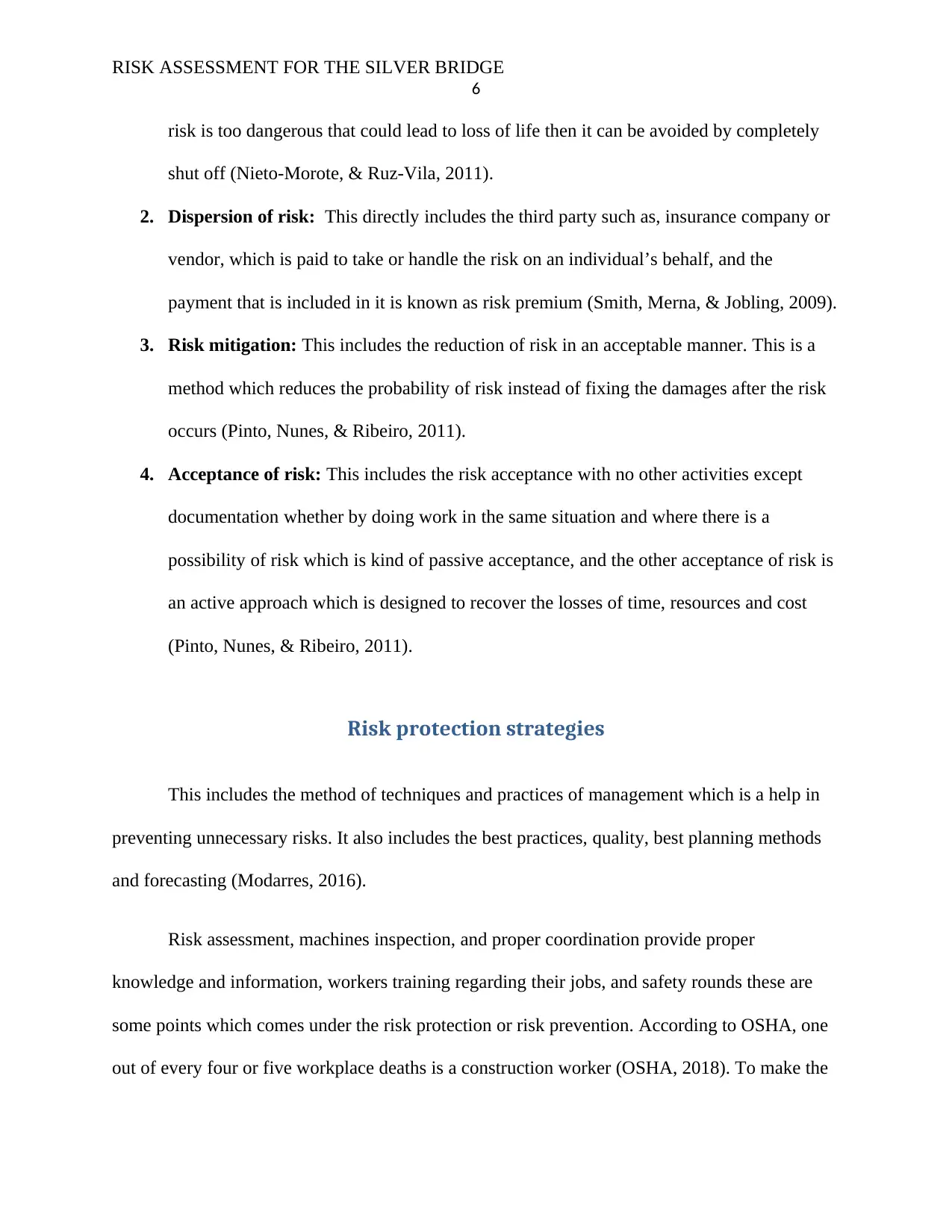
RISK ASSESSMENT FOR THE SILVER BRIDGE
6
risk is too dangerous that could lead to loss of life then it can be avoided by completely
shut off (Nieto-Morote, & Ruz-Vila, 2011).
2. Dispersion of risk: This directly includes the third party such as, insurance company or
vendor, which is paid to take or handle the risk on an individual’s behalf, and the
payment that is included in it is known as risk premium (Smith, Merna, & Jobling, 2009).
3. Risk mitigation: This includes the reduction of risk in an acceptable manner. This is a
method which reduces the probability of risk instead of fixing the damages after the risk
occurs (Pinto, Nunes, & Ribeiro, 2011).
4. Acceptance of risk: This includes the risk acceptance with no other activities except
documentation whether by doing work in the same situation and where there is a
possibility of risk which is kind of passive acceptance, and the other acceptance of risk is
an active approach which is designed to recover the losses of time, resources and cost
(Pinto, Nunes, & Ribeiro, 2011).
Risk protection strategies
This includes the method of techniques and practices of management which is a help in
preventing unnecessary risks. It also includes the best practices, quality, best planning methods
and forecasting (Modarres, 2016).
Risk assessment, machines inspection, and proper coordination provide proper
knowledge and information, workers training regarding their jobs, and safety rounds these are
some points which comes under the risk protection or risk prevention. According to OSHA, one
out of every four or five workplace deaths is a construction worker (OSHA, 2018). To make the
6
risk is too dangerous that could lead to loss of life then it can be avoided by completely
shut off (Nieto-Morote, & Ruz-Vila, 2011).
2. Dispersion of risk: This directly includes the third party such as, insurance company or
vendor, which is paid to take or handle the risk on an individual’s behalf, and the
payment that is included in it is known as risk premium (Smith, Merna, & Jobling, 2009).
3. Risk mitigation: This includes the reduction of risk in an acceptable manner. This is a
method which reduces the probability of risk instead of fixing the damages after the risk
occurs (Pinto, Nunes, & Ribeiro, 2011).
4. Acceptance of risk: This includes the risk acceptance with no other activities except
documentation whether by doing work in the same situation and where there is a
possibility of risk which is kind of passive acceptance, and the other acceptance of risk is
an active approach which is designed to recover the losses of time, resources and cost
(Pinto, Nunes, & Ribeiro, 2011).
Risk protection strategies
This includes the method of techniques and practices of management which is a help in
preventing unnecessary risks. It also includes the best practices, quality, best planning methods
and forecasting (Modarres, 2016).
Risk assessment, machines inspection, and proper coordination provide proper
knowledge and information, workers training regarding their jobs, and safety rounds these are
some points which comes under the risk protection or risk prevention. According to OSHA, one
out of every four or five workplace deaths is a construction worker (OSHA, 2018). To make the
Paraphrase This Document
Need a fresh take? Get an instant paraphrase of this document with our AI Paraphraser
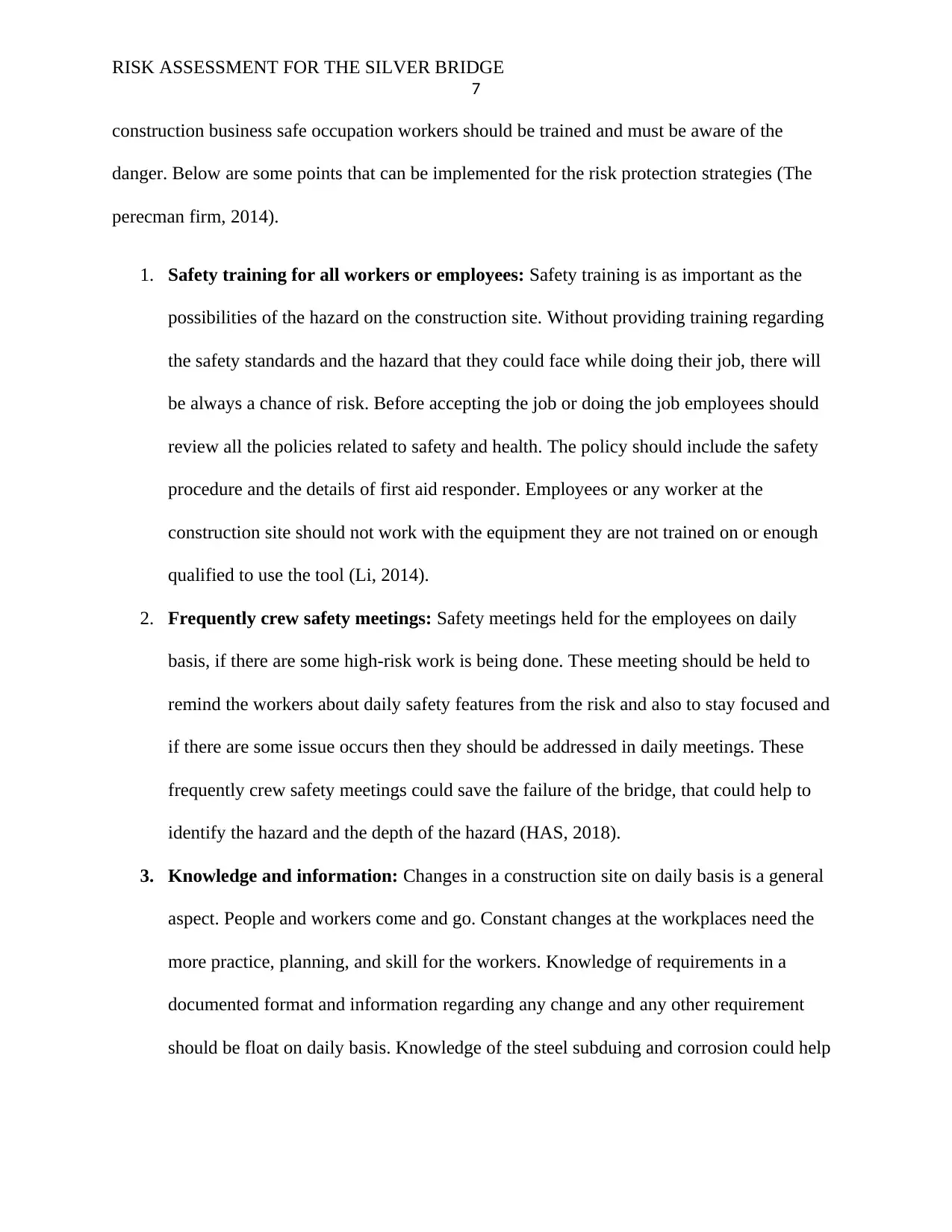
RISK ASSESSMENT FOR THE SILVER BRIDGE
7
construction business safe occupation workers should be trained and must be aware of the
danger. Below are some points that can be implemented for the risk protection strategies (The
perecman firm, 2014).
1. Safety training for all workers or employees: Safety training is as important as the
possibilities of the hazard on the construction site. Without providing training regarding
the safety standards and the hazard that they could face while doing their job, there will
be always a chance of risk. Before accepting the job or doing the job employees should
review all the policies related to safety and health. The policy should include the safety
procedure and the details of first aid responder. Employees or any worker at the
construction site should not work with the equipment they are not trained on or enough
qualified to use the tool (Li, 2014).
2. Frequently crew safety meetings: Safety meetings held for the employees on daily
basis, if there are some high-risk work is being done. These meeting should be held to
remind the workers about daily safety features from the risk and also to stay focused and
if there are some issue occurs then they should be addressed in daily meetings. These
frequently crew safety meetings could save the failure of the bridge, that could help to
identify the hazard and the depth of the hazard (HAS, 2018).
3. Knowledge and information: Changes in a construction site on daily basis is a general
aspect. People and workers come and go. Constant changes at the workplaces need the
more practice, planning, and skill for the workers. Knowledge of requirements in a
documented format and information regarding any change and any other requirement
should be float on daily basis. Knowledge of the steel subduing and corrosion could help
7
construction business safe occupation workers should be trained and must be aware of the
danger. Below are some points that can be implemented for the risk protection strategies (The
perecman firm, 2014).
1. Safety training for all workers or employees: Safety training is as important as the
possibilities of the hazard on the construction site. Without providing training regarding
the safety standards and the hazard that they could face while doing their job, there will
be always a chance of risk. Before accepting the job or doing the job employees should
review all the policies related to safety and health. The policy should include the safety
procedure and the details of first aid responder. Employees or any worker at the
construction site should not work with the equipment they are not trained on or enough
qualified to use the tool (Li, 2014).
2. Frequently crew safety meetings: Safety meetings held for the employees on daily
basis, if there are some high-risk work is being done. These meeting should be held to
remind the workers about daily safety features from the risk and also to stay focused and
if there are some issue occurs then they should be addressed in daily meetings. These
frequently crew safety meetings could save the failure of the bridge, that could help to
identify the hazard and the depth of the hazard (HAS, 2018).
3. Knowledge and information: Changes in a construction site on daily basis is a general
aspect. People and workers come and go. Constant changes at the workplaces need the
more practice, planning, and skill for the workers. Knowledge of requirements in a
documented format and information regarding any change and any other requirement
should be float on daily basis. Knowledge of the steel subduing and corrosion could help
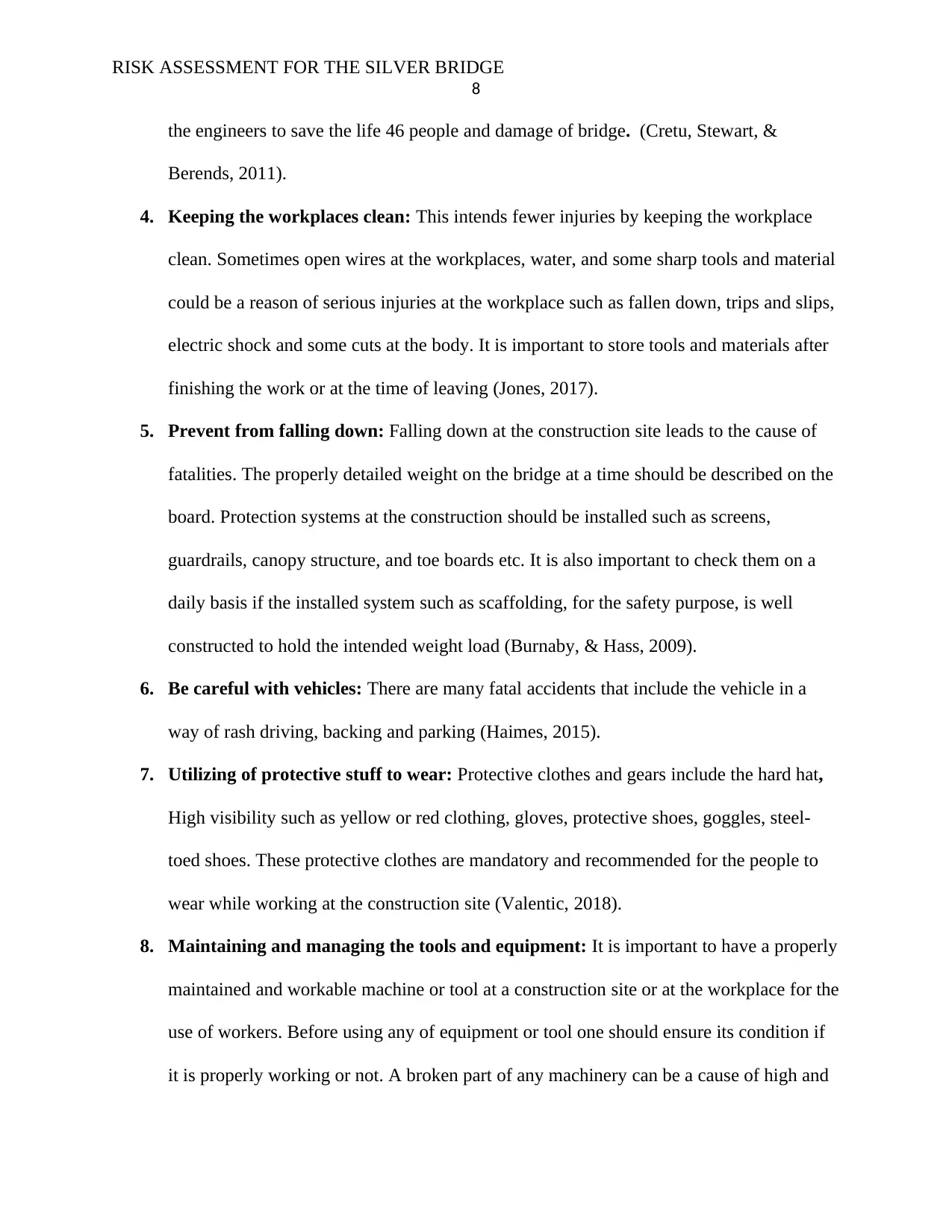
RISK ASSESSMENT FOR THE SILVER BRIDGE
8
the engineers to save the life 46 people and damage of bridge. (Cretu, Stewart, &
Berends, 2011).
4. Keeping the workplaces clean: This intends fewer injuries by keeping the workplace
clean. Sometimes open wires at the workplaces, water, and some sharp tools and material
could be a reason of serious injuries at the workplace such as fallen down, trips and slips,
electric shock and some cuts at the body. It is important to store tools and materials after
finishing the work or at the time of leaving (Jones, 2017).
5. Prevent from falling down: Falling down at the construction site leads to the cause of
fatalities. The properly detailed weight on the bridge at a time should be described on the
board. Protection systems at the construction should be installed such as screens,
guardrails, canopy structure, and toe boards etc. It is also important to check them on a
daily basis if the installed system such as scaffolding, for the safety purpose, is well
constructed to hold the intended weight load (Burnaby, & Hass, 2009).
6. Be careful with vehicles: There are many fatal accidents that include the vehicle in a
way of rash driving, backing and parking (Haimes, 2015).
7. Utilizing of protective stuff to wear: Protective clothes and gears include the hard hat,
High visibility such as yellow or red clothing, gloves, protective shoes, goggles, steel-
toed shoes. These protective clothes are mandatory and recommended for the people to
wear while working at the construction site (Valentic, 2018).
8. Maintaining and managing the tools and equipment: It is important to have a properly
maintained and workable machine or tool at a construction site or at the workplace for the
use of workers. Before using any of equipment or tool one should ensure its condition if
it is properly working or not. A broken part of any machinery can be a cause of high and
8
the engineers to save the life 46 people and damage of bridge. (Cretu, Stewart, &
Berends, 2011).
4. Keeping the workplaces clean: This intends fewer injuries by keeping the workplace
clean. Sometimes open wires at the workplaces, water, and some sharp tools and material
could be a reason of serious injuries at the workplace such as fallen down, trips and slips,
electric shock and some cuts at the body. It is important to store tools and materials after
finishing the work or at the time of leaving (Jones, 2017).
5. Prevent from falling down: Falling down at the construction site leads to the cause of
fatalities. The properly detailed weight on the bridge at a time should be described on the
board. Protection systems at the construction should be installed such as screens,
guardrails, canopy structure, and toe boards etc. It is also important to check them on a
daily basis if the installed system such as scaffolding, for the safety purpose, is well
constructed to hold the intended weight load (Burnaby, & Hass, 2009).
6. Be careful with vehicles: There are many fatal accidents that include the vehicle in a
way of rash driving, backing and parking (Haimes, 2015).
7. Utilizing of protective stuff to wear: Protective clothes and gears include the hard hat,
High visibility such as yellow or red clothing, gloves, protective shoes, goggles, steel-
toed shoes. These protective clothes are mandatory and recommended for the people to
wear while working at the construction site (Valentic, 2018).
8. Maintaining and managing the tools and equipment: It is important to have a properly
maintained and workable machine or tool at a construction site or at the workplace for the
use of workers. Before using any of equipment or tool one should ensure its condition if
it is properly working or not. A broken part of any machinery can be a cause of high and
⊘ This is a preview!⊘
Do you want full access?
Subscribe today to unlock all pages.

Trusted by 1+ million students worldwide
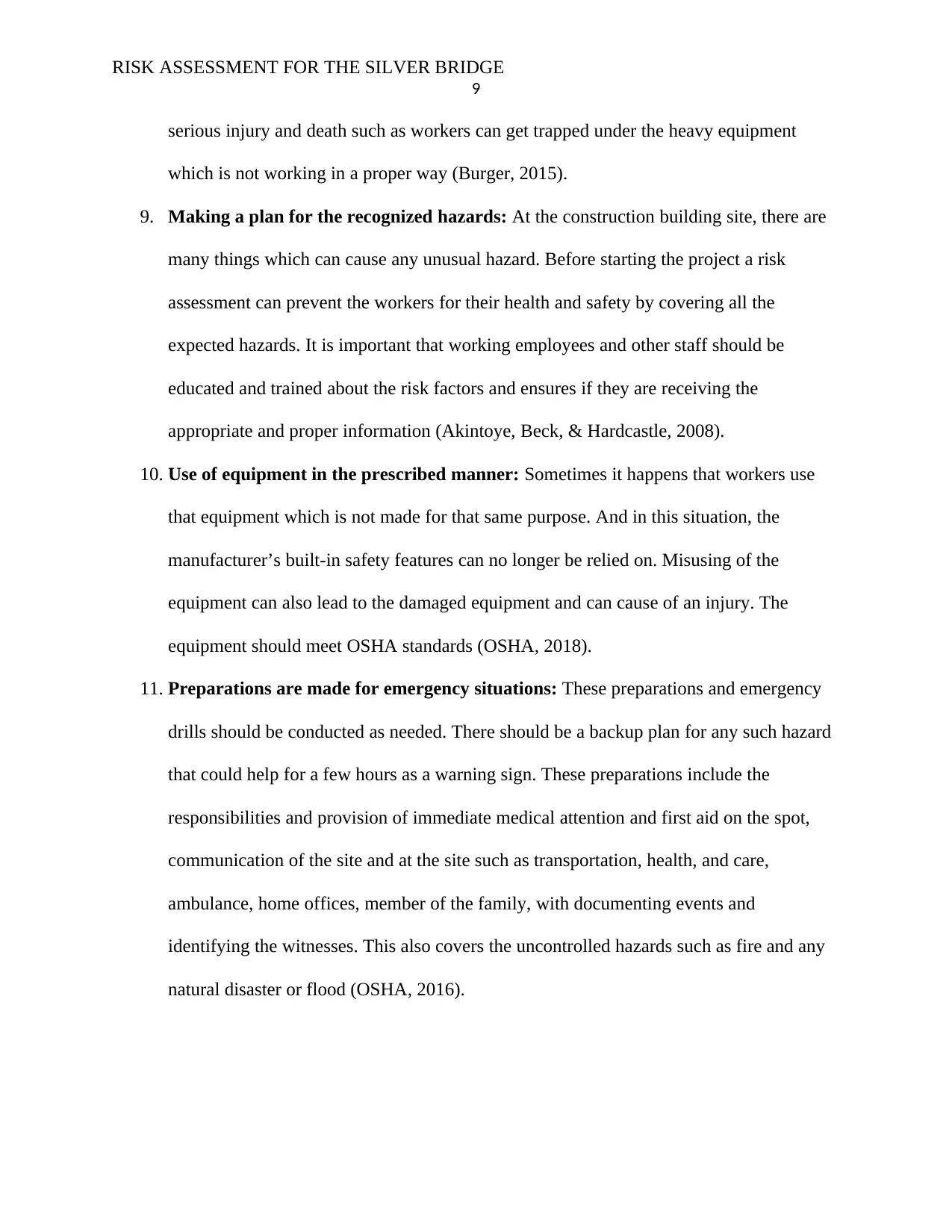
RISK ASSESSMENT FOR THE SILVER BRIDGE
9
serious injury and death such as workers can get trapped under the heavy equipment
which is not working in a proper way (Burger, 2015).
9. Making a plan for the recognized hazards: At the construction building site, there are
many things which can cause any unusual hazard. Before starting the project a risk
assessment can prevent the workers for their health and safety by covering all the
expected hazards. It is important that working employees and other staff should be
educated and trained about the risk factors and ensures if they are receiving the
appropriate and proper information (Akintoye, Beck, & Hardcastle, 2008).
10. Use of equipment in the prescribed manner: Sometimes it happens that workers use
that equipment which is not made for that same purpose. And in this situation, the
manufacturer’s built-in safety features can no longer be relied on. Misusing of the
equipment can also lead to the damaged equipment and can cause of an injury. The
equipment should meet OSHA standards (OSHA, 2018).
11. Preparations are made for emergency situations: These preparations and emergency
drills should be conducted as needed. There should be a backup plan for any such hazard
that could help for a few hours as a warning sign. These preparations include the
responsibilities and provision of immediate medical attention and first aid on the spot,
communication of the site and at the site such as transportation, health, and care,
ambulance, home offices, member of the family, with documenting events and
identifying the witnesses. This also covers the uncontrolled hazards such as fire and any
natural disaster or flood (OSHA, 2016).
9
serious injury and death such as workers can get trapped under the heavy equipment
which is not working in a proper way (Burger, 2015).
9. Making a plan for the recognized hazards: At the construction building site, there are
many things which can cause any unusual hazard. Before starting the project a risk
assessment can prevent the workers for their health and safety by covering all the
expected hazards. It is important that working employees and other staff should be
educated and trained about the risk factors and ensures if they are receiving the
appropriate and proper information (Akintoye, Beck, & Hardcastle, 2008).
10. Use of equipment in the prescribed manner: Sometimes it happens that workers use
that equipment which is not made for that same purpose. And in this situation, the
manufacturer’s built-in safety features can no longer be relied on. Misusing of the
equipment can also lead to the damaged equipment and can cause of an injury. The
equipment should meet OSHA standards (OSHA, 2018).
11. Preparations are made for emergency situations: These preparations and emergency
drills should be conducted as needed. There should be a backup plan for any such hazard
that could help for a few hours as a warning sign. These preparations include the
responsibilities and provision of immediate medical attention and first aid on the spot,
communication of the site and at the site such as transportation, health, and care,
ambulance, home offices, member of the family, with documenting events and
identifying the witnesses. This also covers the uncontrolled hazards such as fire and any
natural disaster or flood (OSHA, 2016).
Paraphrase This Document
Need a fresh take? Get an instant paraphrase of this document with our AI Paraphraser

RISK ASSESSMENT FOR THE SILVER BRIDGE
10
Conclusion
In the conclusion of the above text, risk assessment and its strategies to manage and
maintain the hazard are really important, to stabilize the environment and situation at the time of
hazard. Risk assessment includes the health and safety features to prevent the people internal
(workers) and external (general public). Before starting the construction work proper guidelines
related to safety and health should be implemented and the worker must be educated and trained
over those guidelines. And if any changes are implementing in the middle which was not
mentioned in the requirements then workers should be informed about the same. Workers should
be trained and educated for all the tools and equipment that can be used for the construction
work. The effective risk assessment must include all the functions and processes and it should be
successfully installed in the project to achieve the goal and to gain a clear understanding of the
duties and feasibility of the work. If the proper guidelines were implemented then this hazard
could be avoided by maintaining and managing the bridge aspects in a timely manner.
A risk and control culture should be experienced by everyone included in the project and
the effectiveness of the structural and organizational measures of the risk management. Effective
risk assessment includes the commitments and the risk-conscious behavior of every individual.
For the success of the project motivation and the interplay of the parties should be involved to
determine the quality of the work.
10
Conclusion
In the conclusion of the above text, risk assessment and its strategies to manage and
maintain the hazard are really important, to stabilize the environment and situation at the time of
hazard. Risk assessment includes the health and safety features to prevent the people internal
(workers) and external (general public). Before starting the construction work proper guidelines
related to safety and health should be implemented and the worker must be educated and trained
over those guidelines. And if any changes are implementing in the middle which was not
mentioned in the requirements then workers should be informed about the same. Workers should
be trained and educated for all the tools and equipment that can be used for the construction
work. The effective risk assessment must include all the functions and processes and it should be
successfully installed in the project to achieve the goal and to gain a clear understanding of the
duties and feasibility of the work. If the proper guidelines were implemented then this hazard
could be avoided by maintaining and managing the bridge aspects in a timely manner.
A risk and control culture should be experienced by everyone included in the project and
the effectiveness of the structural and organizational measures of the risk management. Effective
risk assessment includes the commitments and the risk-conscious behavior of every individual.
For the success of the project motivation and the interplay of the parties should be involved to
determine the quality of the work.
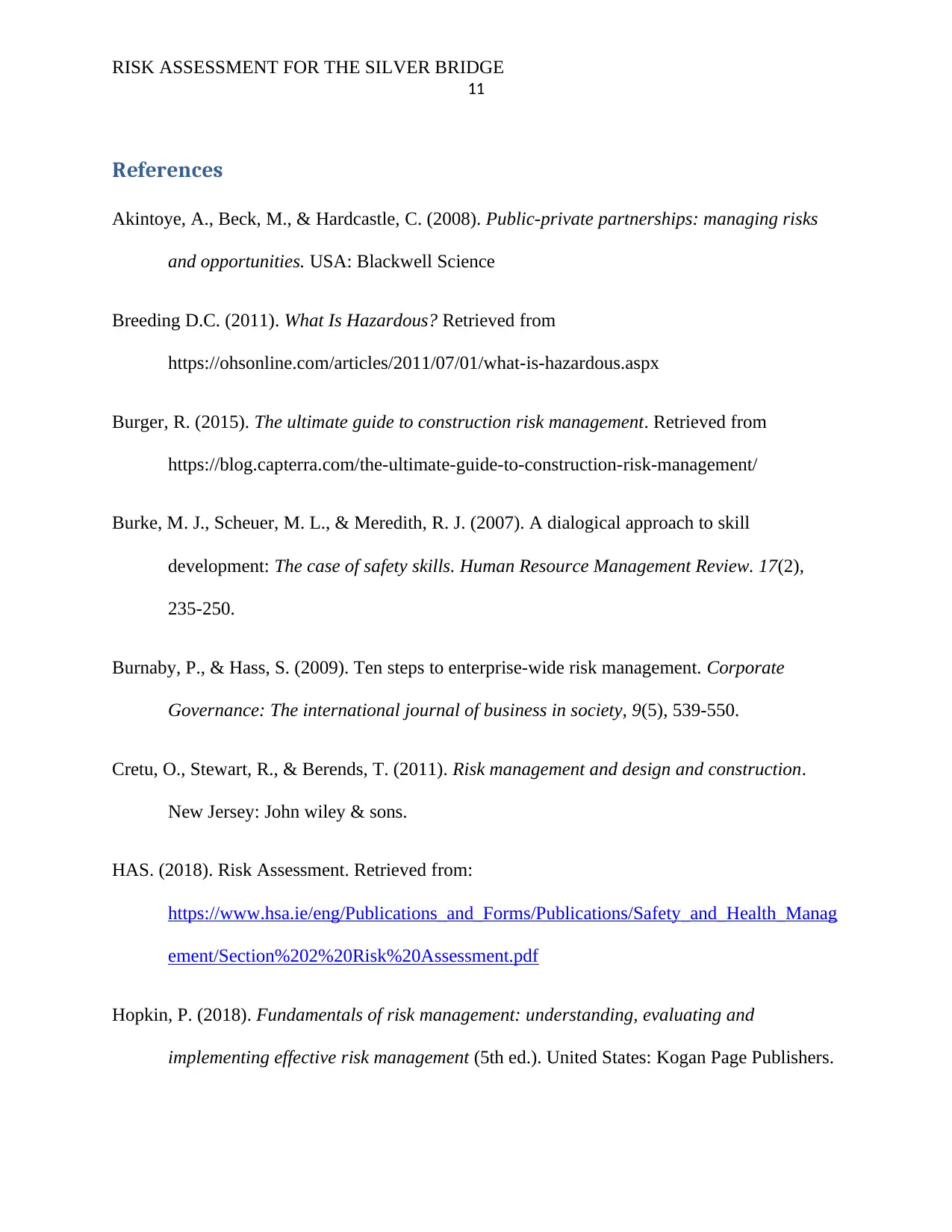
RISK ASSESSMENT FOR THE SILVER BRIDGE
11
References
Akintoye, A., Beck, M., & Hardcastle, C. (2008). Public-private partnerships: managing risks
and opportunities. USA: Blackwell Science
Breeding D.C. (2011). What Is Hazardous? Retrieved from
https://ohsonline.com/articles/2011/07/01/what-is-hazardous.aspx
Burger, R. (2015). The ultimate guide to construction risk management. Retrieved from
https://blog.capterra.com/the-ultimate-guide-to-construction-risk-management/
Burke, M. J., Scheuer, M. L., & Meredith, R. J. (2007). A dialogical approach to skill
development: The case of safety skills. Human Resource Management Review. 17(2),
235-250.
Burnaby, P., & Hass, S. (2009). Ten steps to enterprise-wide risk management. Corporate
Governance: The international journal of business in society, 9(5), 539-550.
Cretu, O., Stewart, R., & Berends, T. (2011). Risk management and design and construction.
New Jersey: John wiley & sons.
HAS. (2018). Risk Assessment. Retrieved from:
https://www.hsa.ie/eng/Publications_and_Forms/Publications/Safety_and_Health_Manag
ement/Section%202%20Risk%20Assessment.pdf
Hopkin, P. (2018). Fundamentals of risk management: understanding, evaluating and
implementing effective risk management (5th ed.). United States: Kogan Page Publishers.
11
References
Akintoye, A., Beck, M., & Hardcastle, C. (2008). Public-private partnerships: managing risks
and opportunities. USA: Blackwell Science
Breeding D.C. (2011). What Is Hazardous? Retrieved from
https://ohsonline.com/articles/2011/07/01/what-is-hazardous.aspx
Burger, R. (2015). The ultimate guide to construction risk management. Retrieved from
https://blog.capterra.com/the-ultimate-guide-to-construction-risk-management/
Burke, M. J., Scheuer, M. L., & Meredith, R. J. (2007). A dialogical approach to skill
development: The case of safety skills. Human Resource Management Review. 17(2),
235-250.
Burnaby, P., & Hass, S. (2009). Ten steps to enterprise-wide risk management. Corporate
Governance: The international journal of business in society, 9(5), 539-550.
Cretu, O., Stewart, R., & Berends, T. (2011). Risk management and design and construction.
New Jersey: John wiley & sons.
HAS. (2018). Risk Assessment. Retrieved from:
https://www.hsa.ie/eng/Publications_and_Forms/Publications/Safety_and_Health_Manag
ement/Section%202%20Risk%20Assessment.pdf
Hopkin, P. (2018). Fundamentals of risk management: understanding, evaluating and
implementing effective risk management (5th ed.). United States: Kogan Page Publishers.
⊘ This is a preview!⊘
Do you want full access?
Subscribe today to unlock all pages.

Trusted by 1+ million students worldwide
1 out of 14
Your All-in-One AI-Powered Toolkit for Academic Success.
+13062052269
info@desklib.com
Available 24*7 on WhatsApp / Email
![[object Object]](/_next/static/media/star-bottom.7253800d.svg)
Unlock your academic potential
Copyright © 2020–2025 A2Z Services. All Rights Reserved. Developed and managed by ZUCOL.